Ryan Hall's Blog, page 301
January 14, 2016
Shoe Talk: Skechers GOrun Forza
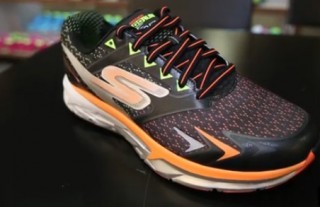
Here’s a closer look at Skechers’ new stability show, the GOrun Forza.
RELATED: Shoe Talk: New Balance Fresh Foam 1080
The post Shoe Talk: Skechers GOrun Forza appeared first on Competitor.com.
Trail of the Week: Linville Gorge Wilderness Loop, North Carolina

Photo: Max Willner
Our Trail of the Week feature is made possible through a partnership with Trail Run Project, a crowd-sourced collaboration by and for the running community. Thanks to Max Willner for mapping and describing this route.
The Linville Gorge Wilderness, in the mountains of western North Carolina, is part of the Pisgah National Forest. The gorge is formed by the Jonas Ridge on the east and Linville Mountain on the west and is bisected by the Linville River which drops 2,000 feet into the valleys below. The terrain is steep and rugged with numerous rock formations. It is covered by dense hardwood/pine forest and a wide variety of smaller trees and other plants.
This loop is 22 miles long, and is considered very strenuous. Due to the rugged backcountry conditions of the Linville Wilderness, it’s a good idea to check in with the rangers and inform them of your travel plans.
Trails are signed at trailheads but are not signed or blazed once inside the wilderness.
The Data
Miles: 22.3
Runnable: 81 percent
Average Grade: 9 percent
Max Grade: 65 percent
Total Ascent: 5,262 feet
Total Descent: -5,264 feet
Highest Elevation: 3,922 feet
For a closer look, check out the interactive map, data, photos and virtual run simulator courtesy of Trail Run Project:
The post Trail of the Week: Linville Gorge Wilderness Loop, North Carolina appeared first on Competitor.com.
Meb Keflezighi, Shalane Flanagan Share Their Thoughts on the Olympic Trials Marathon Course
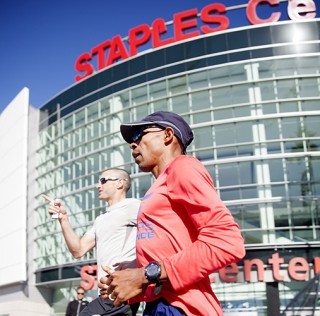
Meb Keflezighi checked out the Olympic Trials course when he was in Los Angeles in November.
Before heading to altitude as part of their respective build-ups, both Meb Keflezighi and Shalane Flanagan paid to a visit Los Angeles to get an up-close look at the Olympic Trials marathon course ahead of the Feb. 13 race.
The spectator-friendly course consists of one 2.2-mile loop through downtown L.A., then four six-mile loops that go south through Exposition Park and the campus of USC. The course is relatively flat but has many turns, including several U-turns.
“I was on it this past weekend,” Flanagan said Thursday on a conference call. “It’s fresh in my memory. I’ve been trying to go through it in my head and re-visit and make sure I don’t forget.
“It’s a fairly simplistic course. The 2.2-mile loop has a lot of turns initially, which will be interesting with a big start.”
The biggest start ever, in fact. As of Thursday, a record 235 women and 200 men have qualified for the race, and 198 women and 155 men have registered. More could qualify this weekend, as races like Rock ‘n’ Roll Arizona, the Houston Marathon and the Naples Daily News Half Marathon will give runners one last shot before the qualifying window closes. Registration for the Trials closes Jan. 31.
RELATED: The Favorite: Interview With Shalane Flanagan
After the initial 2.2-mile loop, runners head south on Figueroa Street, the straightest section of the course, before running through the USC campus and south through Exposition Park. There, a lot of turns await runners within Exposition Park as the course winds past the Los Angeles Coliseum, the California Science Center and more before heading back to Figueroa Street and north toward the start-finish area. Then, they do the loop three more times.
“You gotta make those turns smart and effectively,” said Keflezighi, who ran the course in November and is currently training in Mammoth Lakes, Calif.
Both Flanagan and Keflezighi agreed that the toughest turn might be one of the last ones—a 180-degree U-turn in front of Staples Center about 300 meters from the finish line.
“It’s going to be tough to get around that turn (on tired legs),” said Flanagan, who’s currently training in Flagstaff, Ariz. “That’s probably the most technical aspect.”
Added Keflezighi: “It could be very tactical if it comes down to three people or four people at the end.”
Another factor that may be in play is the weather. Southern California is known for its nice conditions almost year-round, but it’s an El Niño year and the possibility of rainy conditions in Los Angeles looms.
Both Flanagan and Keflezighi said the temperatures in the 40s or 50s would be ideal, and surely a rain-free forecast would draw more spectators.
“It’d be nice to have the ideal California weather,” said Keflezighi, who lives in San Diego. “Fifty degrees is perfect so I don’t have to wear gloves or a beanie.
“Let’s hope it will be somewhere in the 40s or 50s and people will come and cheer us on. It’s good to have fair weather.”
The men’s race starts at 10:06 a.m. PT on Feb. 13 and the women go at 10:22 a.m. The top three men and top three women will qualify for the 2016 Olympics in Rio.
The post Meb Keflezighi, Shalane Flanagan Share Their Thoughts on the Olympic Trials Marathon Course appeared first on Competitor.com.
Want to Run the 2016 Chicago Marathon? Here’s What You Need to Know

Photo courtesy of the Bank of America Chicago Marathon.
The Chicago Marathon is one of the most popular races in the world, and subsequently, the demand for one of the 40,000-plus bibs is sky high. This week, officials released details about the application process for those interested in running the 2016 Chicago Marathon on Oct. 9.
RELATED: Photos: 2015 Chicago Marathon
Guaranteed Entries
Applications for guaranteed entries will be accepted from March 8 to April 12, 2016. Guaranteed entries are extended under the following criteria:
Legacy finishers: Runners who have finished the Chicago Marathon at least five times between 2006 and 2015 can get guaranteed entry in 2016.
Time qualifier: Men who have run a verifiable sub-3:15 marathon and women who have run a verifiable sub-3:45 marathon after Jan. 1, 2014 can get guaranteed entry.
2015 deferments: For those who completed the process to defer their 2015 entry.
Charity program runners: For those who opt to run and fundraise for one of the official charity partners.
International Tour Group runners: For international runners who opt to join a tour group (more information to come on this option).
Non-Guaranteed Entries
For those who don’t qualify for guaranteed entry, you can apply for the lottery. Applications are accepted from March 15 through April 12, with a random lottery to be conducted after that.
Entry fees for U.S. residents are $185, and for non-residents it’s $210.
The Chicago Marathon first initiated a lottery in 2014 due to high demand. That year, more than 70,000 runners applied, with more than 40,000 getting a bib that year. The race is one of the largest marathons in the world and one out of six World Marathon Major races.
RELATED: A Statistical Breakdown of the 2015 Chicago Marathon
The post Want to Run the 2016 Chicago Marathon? Here’s What You Need to Know appeared first on Competitor.com.
8 Ways Protein Spikes Can Improve Your Fitness

Photo: Shutterstock.com
What if I told you that you could get stronger, fitter, and leaner just by downing a delicious 12-ounce, protein drink a few times a day—without changing anything else in your fitness routine? You’d probably think I’d been reading too much Alice in Wonderland (“DRINK ME”) or that I was shilling for the $30 billion per year supplement industry. But I’m not.
Both scientific and anecdotal evidence shows that protein supplementation will significantly improve the results of your fitness program. “If you regularly take in a spike of 15 grams of protein,” says Steve Magness, exercise scientist, coach and author of The Science of Running, “you’ll get a spike in muscle protein synthesis. If you do that every couple hours, what [studies] have found is that it keeps you in an anabolic state.” And how does being in an anabolic state (i.e., a state in which your body “builds up” organs and tissues) benefit your program? Let’s count eight ways:
1. Increases muscle size
2. Increases muscle strength
3. Reduces muscle soreness post-training
4. Accelerates gains in aerobic strength
5. Accelerates gains in anaerobic strength
6. Results in greater fat loss when dieting
7. Results in fat loss even when not dieting
8. Reduces hunger
If that sounds too good to be true, well, it isn’t. Protein supplementation dates to the Olympians of Ancient Greece, with National Geographic citing a “cheese- and fruit-based diet” for the original Olympians (a later, meat-only craze was launched when an Olympian won multiple events on a meat-only diet). In modern times, bodybuilders embraced protein supplementation more than a century ago, with protein powders becoming popular in the 1950s. More recently, science has added its seal of approval. A 2015 review of 32 studies found that “as the duration, frequency, and volume of resistance training increase, protein supplementation may promote muscle hypertrophy [i.e., bigger muscles] and enhance gains in muscle strength … Evidence also suggests that protein supplementation may accelerate gains in both aerobic and anaerobic power.” A 2014 review of 27 studies concluded that “beneficial effects [for endurance and resistance training] such as reduced muscle soreness and markers of muscle damage become more evident when supplemental protein is consumed after daily training sessions.”
For those interested in dieting, a 2007 study had 158 participants reduce their caloric intake by 500 calories per day, with one group consuming a twice-daily isocaloric (moderate carbohydrate, moderate fat) supplement and another group consuming a whey protein supplement. The second group lost almost twice as much fat as the first group, while simultaneously losing far less lean muscle mass.
And if you’re interested in reducing fat without dieting, a 2011 study followed two non-dieting groups, one who consumed whey protein supplements and one who consumed a supplement with carbohydrates. After 23 weeks, the protein group had reduced average body fat by five pounds compared to the carbohydrate group. Consuming protein also resulted in a “significantly smaller waist circumference” than consuming carbs.
Additionally, numerous studies have shown that protein supplementation reduces hunger by increasing satiety (i.e., the feeling of fullness you get after eating).
For endurance athletes, Magness explains that the timing of protein supplementation is crucial. “For breakfast, lunch, and dinner, try to get 15 grams of protein in each,” he says. “And if you’re running [or performing some other exercise] once or twice a day, after each one try to get in some protein … If you take a big spike of protein before bed—around 30 grams—you’ll get a huge spike in protein synthesis overnight, which is when a bunch of muscle repair and recovery goes on. It’s one of those cool things that, just through the timing, you get this effect.”
RELATED: The 11 Best Protein Sources For Runners
Once you’ve decided to include protein spikes in your fitness program, you’ll next have to decide on the type of protein. Magness recommends “natural sources of protein.” These can include eggs, milk, fish, nuts, chicken and other meats. You can also travel the protein drink path—the aforementioned “delicious” alternative to preparing a high-protein meal (protein powder comes in vanilla, chocolate, and strawberry flavors, among others, and is mixed with water or milk). Whey protein is the most popular powder. It’s absorbed quickly and is high in branched-chain amino acids, which promote protein synthesis, improved recovery, and body fat reduction. You might also consider simultaneous carbohydrate supplementation, as carbs will trigger the release of the hormone insulin, which helps your muscle cells to absorb amino acids (the building blocks of protein).
Manipulating the source of caloric intake to reap fitness benefits is nothing new. Marathoners in the 1960s discovered that carbo-loading could increase their muscle glycogen (fast-acting energy) stores by 100 percent. And Ironman triathletes and ultrarunning participants regularly improve performance by switching to fat-based diets ahead of races, which trains their bodies to burn more fat (an almost inexhaustible source of energy) during long, grueling competitions. Similarly, fitness enthusiasts looking to shed fat and improve strength, recovery, and endurance should embrace multiple protein spikes throughout the day. It’s a simple and effective tool for maximizing the benefits of your regular training program and diet.
RELATED: Protein Intake and Performance
The post 8 Ways Protein Spikes Can Improve Your Fitness appeared first on Competitor.com.
New WADA Report Says Corruption ‘Embedded’ In IAAF

IAAF Sebastian Coe's hot seat got a bit warmer after Thursday's IAAF follow-up report on the Russian doping scandal. Photo: PhotoRun
The latest installment of the seemingly never-ending doping investigation in track and field revealed that the International Association of Athletics Federations (IAAF) was even more corrupt than originally thought. At a press conference in Munich on Thursday, the World Anti-Doping Agency’s follow-up investigation into the much ballyhooed Russian doping scandal that was first brought to light in early November found that, “The IAAF Council could not have been unaware of the extent of doping in Athletics and the non-enforcement of applicable anti-doping rules.”
Among a litany of other findings, Thursday’s 89-page report said that former IAAF president Lamine Diack—who was arrested in France last November on charges of corruption and money laundering—told a lawyer to cut a deal with Russian president Vladimir Putin to ensure nine Russian athletes accused of doping would not compete at the 2013 world championships in Moscow.
RELATED: WADA Report Reveals Widespread Russian Doping
“The corruption that occurred within the IAAF was not at the level of some foreign currency trader in a bank carrying out unauthorized transactions, without the knowledge or permission of the responsible bank officers,” it says on page 46 of the report. “Here, it started with the President of the organization. It involved the Treasurer of the organization. It involved the personal counsel of the President, acting on instructions of the President. It involved two of the sons of the President. It involved the director of the Medical and Anti-Doping department of the IAAF. The corruption was imbedded in the organization.”
The report also details a sudden and massive increase ($6 million to $25 million) for Russian TV rights at the 2013 world championships, an arrangement led by Diack’s son, his lawyer, Russian bank VTB and Russian athletics federation head Valentin Balakhnichev, who also served as “honorary treasurer” of the IAAF. The report called for the IAAF to “undertake a forensic examination of the relationship and how the rights were awarded to determine whether there were any improprieties.”
This puts tremendous pressure on current IAAF president Sebastian Coe, a two-time Olympic champion runner who became an IAAF council member in 2003, vice president in 2007 and was elected president last August, to provide answers and restore faith in track and field’s crumbling governing body. Coe, who reluctantly stepped down from a paid ambassadorship role at Nike in November, insists he knew nothing about corruption or cover-ups within the organization.
Dick Pound, the former head of WADA who had led the last two independent investigations, seems to think Coe is the right man for the job, despite the intense scrutiny the former Olympic champion and world-record holder has faced from the media.
“As far as the ability of Lord Coe to remain at the head of the IAAF, I think it’s a fabulous opportunity for the IAAF to seize this opportunity and under strong leadership to move forward out of this,” Pound said at Thursday’s press conference. “There’s an enormous amount of reputational recovery to do here and, descending to personalities, I can’t think of anyone better than Lord Coe to lead that. So all out fingers are crossed in that respect.”
RELATED: An Open Letter To IAAF President Sebastian Coe
The Abbott World Marathon Majors—an organization of the world’s six premier marathons (Boston, New York, Berlin, London, Chicago and Tokyo)—was quick to release a statement on Thursday morning in support of the report from WADA and clean sport to maintain trust among marathon runners and fans.
“It is a shocking wake-up call not just for the IAAF, but for all international sports federations,” the statement said. “The AbbottWMM will continue to take every action possible to ensure that marathon running is a safe haven from doping. As we have said before, we cannot do this alone and have relied on the IAAF as our partners. We know that the IAAF will continue to be under close scrutiny and we support IAAF President Seb Coe’s plans for full-scale reforms within the organization. We want to work with the IAAF to ensure these reforms are delivered in the right way. We are determined to ensure that our sport is clean and well-managed.”
The statement also pointed out that the World Marathon Majors has created the world’s biggest privately funded anti-doping program, with more than 150 named athletes required to participate in a minimum of six out-of-competition tests each year (these tests are in addition to IAAF or National Federation tests). And it has revised its payment process for the series prize money so that the $500,000 prize purse for each individual series winner is paid out over a five-year period, thus enabling effective financial penalty if there are subsequent biological passport mapping issues.
In addition, any athlete who has been found guilty of any anti-doping rules enforced by the IAAF, WADA, National Federations or any of the individual marathons in the series is not eligible to win the AbbottWMM Series title. Furthermore, any athlete banned for more than six months by the IAAF, WADA, National Federations or any of the individual AbbottWMM races for a doping offence is banned for life from AbbottWMM Series races.
The post New WADA Report Says Corruption ‘Embedded’ In IAAF appeared first on Competitor.com.
January 13, 2016
Abdirahman Leading the Way for Olympic Hopefuls at Rock ‘n’ Roll Arizona
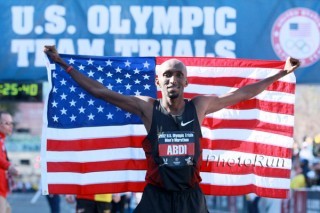
In 2012, Abdirahman took third in the Olympic Trials Marathon held in Houston, Texas. This year will be his fifth attempt at making an Olympic team. Photo: Photorun.net
While long-distance running may appear to be a solitary affair, if you ask four-time U.S. Olympian Abdi Abdirahman, you will most likely get a shake of the head. The 39-year-old pro, who enjoys the moniker “Black Cactus,” will be toeing the start line at the Rock ‘n’ Roll Arizona Half Marathon on Jan. 17 in Tempe with one big goal in mind: Help his fellow elite runners qualify for the U.S. Olympic Trials Marathon.
The Rock ‘n’ Roll Arizona Half Marathon is the last chance for many runners to qualify for the Trials on Feb. 13 in Los Angeles. A blistering time of one hour and five seconds for 13.1 miles, which equates to 4:57 per mile, is required for men to book their ticket to the Trials. The top three runners in that event are then selected to represent the U.S. at the Summer Games in Rio de Janeiro.
On Sunday, Abdirahman will be leading the 1:04:45 group. “I’m looking forward to heading to Rock ‘n’ Roll Arizona,” he says. “It’s the last day for people to qualify for the Olympic Trials so my goal is to run hard, run solid and help as many people get across that line under 65 minutes.”
Abdirahman has been a staple on the American distance-running circuit for nearly 20 years. His career highlights have included a top-10 finish at the 2000 Olympics in the 10,000-meter event, as well as winning the U.S. Trials in the same event that year. In the 2012 U.S. Olympic Trials Marathon held in Houston, Texas, he took third, which was good enough to compete at the London Olympic Games.
For Abdirahman, returning to Arizona for an attempt to make his fifth Olympic squad couldn’t be more fitting. The Somali-born U.S. citizen attended high school in Tucson and went on to compete and eventually graduate from the University of Arizona as a repeat PAC-10 champion in numerous distances on the track and turf.
In addition to the men, a large contingent of women elite runners are also pinning their Olympic hopes on the fast Arizona course on Sunday. Qualifying standards for them mean either clocking a 2:45 in the marathon or a 1:15 in the half marathon.
“There is nothing in any sport, not just running, like the pursuit of the Olympic dream,” says Tracy Sundlun, senior vice president for the Rock ‘n’ Roll Marathon Series. “It’s always driven boys and girls, men and women. It doesn’t get old. It doesn’t change. For these athletes, it’s a life-changing experience to put everything on the line. I’m proud that we have someone like Abdi with us here in Arizona. He’s come full circle in his career back to the Rock ‘n’ Roll Arizona race—back to his roots.”
Along with Abdirahman and a contingent of Olympic Trials hopefuls, a total of 20,000 other runners of all abilities from all over the world will be taking part in a thrilling weekend of races. The Rock ‘n’ Roll Arizona 5K presented by Brooks kicks off festivities on Saturday, and a 10K takes place in conjunction with the half and full marathons on Sunday. Alternative rock trio Better than Ezra will then serenade all finishers and their families at the post-race concert.
RELATED: Living the Dream: Merely Qualifying for the U.S. Olympic Trials Marathon is a Huge Feat
The post Abdirahman Leading the Way for Olympic Hopefuls at Rock ‘n’ Roll Arizona appeared first on Competitor.com.
Research Reveals Elite Females Better at Marathon Pacing
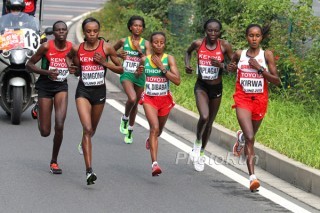
Photo: PhotoRun.net
According to a new study, published in the Journal of Sports Sciences, elite women marathoners are better at pacing than their male counterparts. Dr. Brian Hanley, a senior lecturer in sport and exercise biomechanics at Leeds Beckett University in England, had conducted the research over the course of 14 years (from 2001 to 2015), investigating the pacing profiles of 673 men and 549 women competing in the IAAF World Championships and Olympic marathons.
The results found that, overall, women slowed down less and were less likely to drop out of a race due to their conservative starting paces as opposed to men who demonstrated a more aggressive approach in the beginning. This conservative start also meant that top women athletes relied more on a sprint finish in the final mile to decide medal places more than the top male runners.
“While it is not fully understood whether the pacing difference between men and women is based in physiology or psychology, women taking part in mixed, large-city marathons should note that running with other women of the same ability is more likely to result in an even pace than following the over-ambitious speed set by men,” Dr. Hanley explained in a press release.
This would explain why we see larger and tighter lead packs throughout a marathon, from start to finish, more so in women’s races than in men’s races. Regardless of gender though, the research also concluded that pack running is highly beneficial for the individual runner. Collected data indicated that medalists of both sexes maintained an even pace from 10K onwards when running with a group throughout the entire race whereas slower finishers, who only ran with others for part of the race, dropped off the lead pack around the 13.1-mile mark.
From a mental perspective, pack running makes sense. It can reduce the mental load of running alone over long distances when competitive motivation isn’t enough.
However, sticking with the lead group isn’t always an easy feat, especially after 20 miles when fatigue and everything that could go wrong in a marathon usually occurs at this point. Thus, based on his research, Dr. Hanley advises to choose someone with similar abilities or ambitions at the start of a race.
“For this reason, any runner taking part in upcoming marathons, such as in London, are advised to ensure they line up in the appropriate start pen, so that this form of symbiotic pacing can help them achieve even-paced running and potentially better performances,” he concludes.
RELATED: 3 Pacing Strategies to PR Your Next Race
The post Research Reveals Elite Females Better at Marathon Pacing appeared first on Competitor.com.
10 Amazing International Races
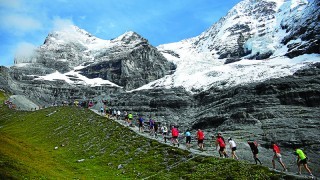
The Jungfrau Marathon in Switzerland. Photo courtesy of the Jungfrau Marathon.
One of the great things about running a race in another country is that you get to see the sights and experience the culture of another place while still doing what you love most. No matter where you go, you’ll find that there is a universal language of running. Consider these vacation-worthy races in the near future.
Tokyo Marathon
Feb. 28, Tokyo
Tokyo is one of the world’s great running centers. The course takes in some of the most spectacular sights in the Japanese capital, starting at the Tokyo Metropolitan Government building as it swings past the Imperial Palace, the huge Hibiya city park, Ginza’s upmarket shopping area and the Buddhist temple within the ancient geisha district of Asakusa, to name but a few. (Marathon.tokyo/en)
London Marathon
April 24, London
Run like a Connecticut Yankee in King Arthur’s Court. Like all big city marathons, this one is very hard to enter, but there are slots set aside for Marathon Tours & Travel. The race is run on a fast and flat course that winds along the River Thames before reaching the dramatic finish in The Mall in front of Buckingham Palace. Dine on fish and chips washed down with a fine ale. (virginmoneylondonmarathon.com)
Prague Marathon
May 8, Prague
Prague, the 14th largest city in Europe, was one of the few that wasn’t decimated by bombing during World War II, which means many buildings dating back to the 18th century are intact. Now in its 20th year, the Prague Marathon is one of the world’s most international marathons, with two-thirds of runners coming from 55 other countries. The course generally follows the Vltava River, starting and finishing in Old Town Square between Wenceslas Square and the Charles Bridge. (praguemarathon.com/en)
The Great Wall Marathon
May 21, Tianjin, China
Put this once-in-a-lifetime race on your bucket list, but train as if you’re going to run an ultra-distance mountain race. While it’s only a 26.2-mile marathon, it features a ridiculous amount of vertical gain and drop on steep staircases as the Great Wall of China—the only manmade element visible from space—winds through the countryside. (great-wall-marathon.com)
Mont Blanc Marathon
June 26, Chamonix, France
The Mont Blanc Marathon is just what it sounds like: A marathon run in the heart of one of the world’s trail running meccas. While the first half of the race sends runners on smooth, flat, rolling paths through several villages, the second half is mostly on singletrack trails that climb to a mountaintop finish at the Brevent ski area more than 5,000 feet above the starting line on the valley floor. (Montblancmarathon.net/en)
Jungfrau Marathon
Sept. 10, Interlaken, Switzerland
One of the world’s great trail running races, the Jungfrau Marathon starts out with a flat initial 10K along Lake Brienz, but then sends runners up a relentless climb toward the Eiger, Mönch and Jungfrau mountains. The mountaintop finish at nearly 7,000 feet above sea level is truly amazing, offering stunning scenery at the heart of the Swiss Alps.(jungfrau-marathon.ch/en)
Cape Town Marathon
Sept. 18, Cape Town
The Cape Town Marathon has earned rave reviews in recent years as a first-class international marathon, especially since South African running legend Elana Meyer and rugby icon Francois Pienaar have become the principal figureheads of the race organization. The picturesque course starts in Green Point Urban Park near the sea and takes runners along Cape Town Harbor, through the city, along the tree-lined streets of the outlying neighborhoods below Devil’s Peak and Table Mountain, and past iconic landmarks in the city center—including the place where Nelson Mandela gave his first speech upon being released from prison in 1990—before finishing in Cape Town Stadium. (capetownmarathon.com)
Patagonian International Marathon
Sept. 24, Patagonia, Chile
This marathon sends runners onto the rolling gravel roads and dirt paths of Torres del Paine National Park in Chilean Patagonia. Runners in each of the four races (10K, 21K, 42K and 63K) set off from separate, remote starting lines, but ultimately wind up at the same finishing point inside the preserved parklands. Each course offers breathtaking scenery and unique features, including multicolored lakes, majestic peaks or roaring rivers. (patagonianinternationalmarathon.com/en)
Berlin Marathon
Sept. 25, Berlin
One of the fastest marathons every year (partially because it has a world-class field), the Berlin Marathon has been the site of nine world records over the past 18 years. The course winds through the Berlin metropolis and starts and finishes near the Brandenburg Tate, the city’s famous 18th century neoclassical triumphal arch. (bmw-berlin-marathon.com/en)
Rock ‘n’ Roll Lisbon Half Marathon
Oct. 2, Lisbon
Part of the Rock ‘n’ Roll Marathon Series’ growing collection of international races, this race has more than 30 live bands on the course and gives a tour of the Portuguese capital. Runners take on a flat, point-to-point race that starts in the beach town of Cascais, travels along the banks of the Tagus River and over the stunning Vasco de Gama Bridge—the longest bridge in Europe—and ends in the city center. (pt.competitor.com/portugal)
The post 10 Amazing International Races appeared first on Competitor.com.
2016 Boston Marathon Field Features Four Past Champions
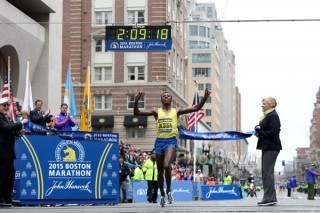
Lelisa Desisa leads a strong international field at the 2016 Boston Marathon. Photo: PhotoRun.net
(c) 2016 Race Results Weekly, all rights reserved. Used with permission.
The elite field for the 120th Boston Marathon, scheduled for Monday, April 18, boasts four former race champions and athletes representing 11 different nations, organizers announced today. John Hancock Financial, which is in its 31st year as principal sponsor of America’s oldest marathon, said athletes in this year’s field had won 16 Abbott World Marathon Majors events, Olympic and IAAF World Championships medals, and 89 global marathons.
“We welcome back our past champions and an exceptional elite field from around the world for the 120th running of the Boston Marathon,” said Rob Friedman, Hancock’s head of sponsorship and event marketing through a statement. “During our sponsorship we have hosted more than 700 elite athletes from 46 countries, and each year these talented athletes run a strategic and exciting race for millions of fans around the globe. We wish this year’s team all the best in their final Boston Marathon preparations and look forward to cheering for them on Marathon Monday.”
Reigning Boston champions Lelisa Desisa of Ethiopia and Caroline Rotich of Kenya lead the field. Desisa, who has a career best time of 2:04:45, also won the race in 2013 and was the third place finisher at last November’s TCS New York City Marathon. Rotich, whose best time is 2:23:22, won Boston for the first time last year and hopes to bounce back from a disappointing 10th-place finish in New York.
Two other athletes, Kenya’s Geoffrey Mutai and Wesley Korir, have also claimed victory in Boston. Mutai ran the still-standing Boston course record of 2:03:02 (and personal best) in 2011 in a year where athletes enjoyed a strong tailwind from Hopkinton to Back Bay. Korir prevailed in very hot conditions one year later, clocking 2:12:40, the slowest winning time in the last eight editions of the race. His career best time is 2:06:13.
Other notable athletes on the men’s side include Kenya’s Sammy Kitwara (2:04:28 PB), the 2010 IAAF World Half-Marathon Championships silver medalist; Ethiopia’s Yemane Tsegay, the 2015 IAAF World Championships Marathon silver medalist (2:04:48); Kenya’s Wilson Chebet, the three-time Amsterdam Marathon winner and 2014 Boston Marathon runner-up; and American Ian Burrell, who is bypassing the U.S. Olympic Trials Marathon to run Boston instead.
On the women’s side, 2012 Olympic Marathon champion, Tiki Gelana of Ethiopia (2:18:58 PB) is the fastest woman in the field and will be making her Boston Marathon debut. Four other Ethiopian woman—Buzunesh Deba (2:19:59), Tirfi Tsegaye (2:20:18), Mamitu Daska (2:21:59), and Atsede Bayisa (2:22:03) are among the five-fastest women in the race. Also competing are two-time New York City Marathon winner Jelena Prokopcuka of Latvia (2:22:56 PB) and Americans Sarah Crouch (2:32:44) and Neely Spence Gracey (debut). Crouch had to withdraw from the Olympic Marathon Trials, scheduled for February 13, because of an injury and has changed her focus to compete in Boston.
“I will state my goal loudly right now,” Crouch wrote on her blog earlier this week. “I want to be the top American at Boston this year.”
Officials at the Boston Athletic Association (B.A.A.), the Boston-based not-for-profit race organizer which owns and manages the race, were pleased with the field.
“We already look forward to welcoming these top international marathoners to Boston in April,” said Tom Grilk, the organization’s executive director through a prepared statement. “Our team works year-round to play host and set a stage worthy of the caliber of professional athletes that will run here along with the rest of the splendid athletes in our field. We wish the John Hancock Elite Athlete Team members good luck with their training with fewer than 100 days to go until our 120th race.”
The 2016 Boston Marathon kicks off the Abbott World Marathon Majors Series X, the richest and most prestigious series of marathons in the world. Series X will also end at Boston in 2017. The current series, Series IX, will conclude at the Tokyo Marathon on February 28.
The post 2016 Boston Marathon Field Features Four Past Champions appeared first on Competitor.com.
Ryan Hall's Blog
- Ryan Hall's profile
- 21 followers



